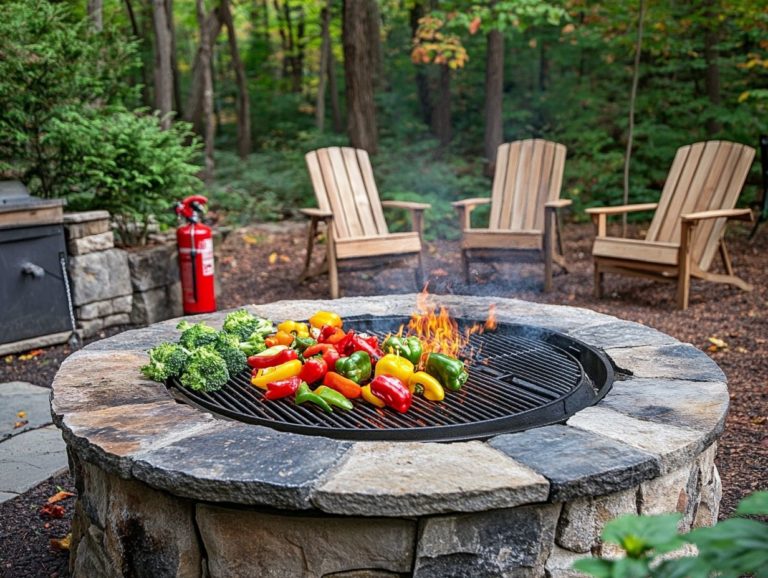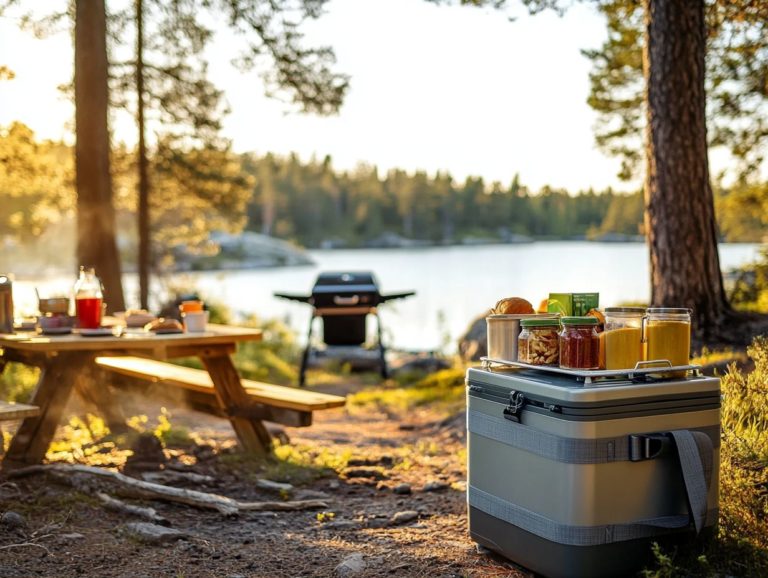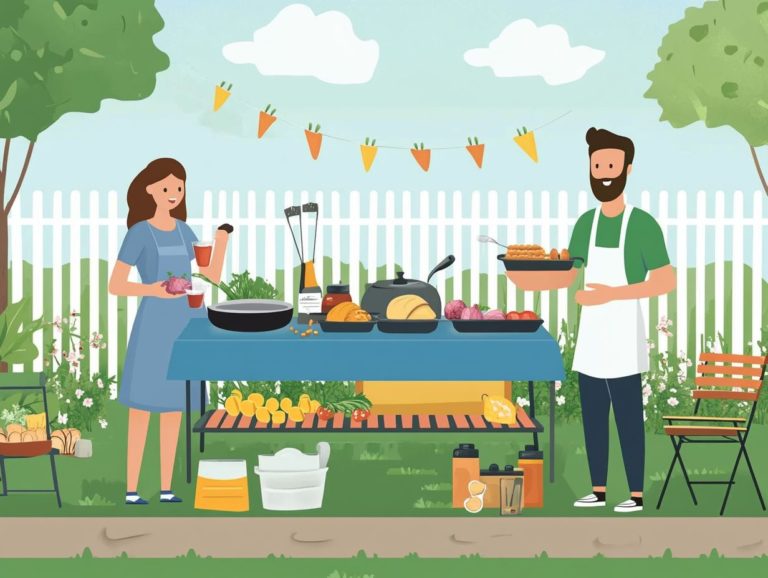Top 5 Food Safety Tips for Outdoor Events
Planning an outdoor event can be a delightful experience, but ensuring food safety is paramount. Whether you’re hosting a picnic or a barbecue, the joy of gathering with friends and family can swiftly diminish if foodborne illnesses make an unwelcome appearance.
Here are some easy tips for food hygiene:
- Keep temperatures in check, especially in the danger zone.
- Use separate utensils for raw and cooked foods to prevent mixing and spreading germs.
- Maintain cleanliness throughout your setup.
You’ll also learn about common mistakes people make and how to educate others on safe practices. Get ready to enjoy your next outdoor feast with confidence!
Contents
- Key Takeaways:
- 1. Keep Cold Foods Cold and Hot Foods Hot
- 2. Use Separate Cutting Boards and Utensils for Raw and Cooked Foods
- 3. Wash Hands Frequently
- 4. Use a Thermometer to Ensure Proper Cooking Temperature
- 5. Store and Transport Food Safely
- Why Is Food Safety Important for Outdoor Events?
- What Are the Most Common Causes of Foodborne Illnesses?
- What Are the Best Ways to Keep Food Safe at Outdoor Events?
- What Are the Most Common Food Safety Mistakes Made at Outdoor Events?
- How Can You Educate Others about Food Safety at Outdoor Events?
- What Are Some Tips for Safe Grilling at Outdoor Events?
- Frequently Asked Questions
- What are the top 5 food safety tips for outdoor events?
- Why is it important to keep hot and cold foods at the right temperatures?
- How often should I wash my hands when handling food at an outdoor event?
- Why is it important to use separate cutting boards for raw and cooked foods?
- How can I protect my food from insects and pests at an outdoor event?
- What are some ways to properly pack and store food for an outdoor event?
Key Takeaways:
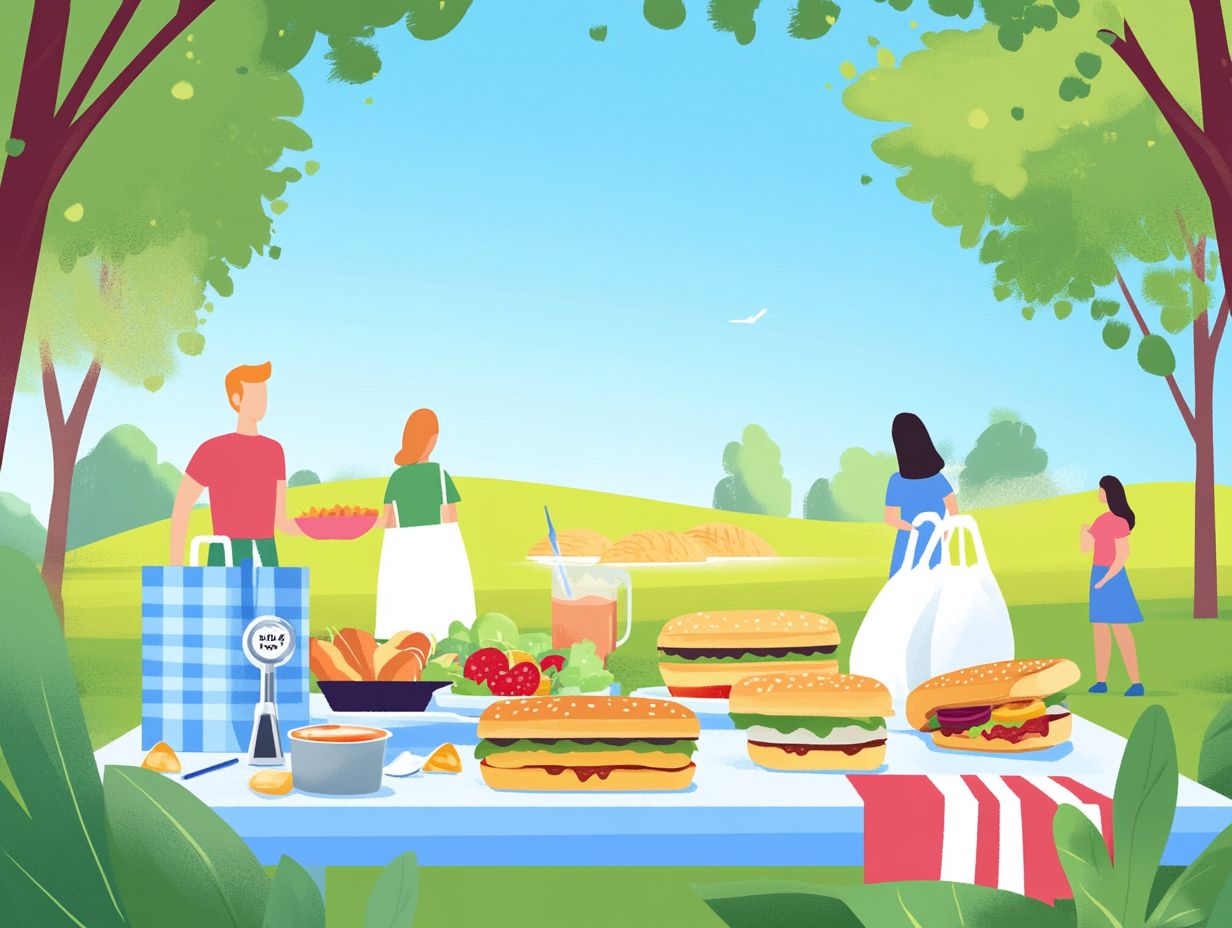
- Keep food at proper temperatures to prevent foodborne illnesses.
- Use separate cutting boards and utensils for raw and cooked foods to avoid mixing and spreading germs.
- Wash hands frequently to prevent the spread of germs, especially among food handlers.
1. Keep Cold Foods Cold and Hot Foods Hot
Maintaining the right temperatures for food is crucial for safety, especially during summer cookouts, holiday celebrations, weddings, and outdoor gatherings. Foodborne illnesses can easily strike due to improper handling of perishable food.
To keep cold foods at safe temperatures below 40 F and hot foods above 140 F, inhibit the growth of harmful bacteria. This is particularly important when cooking for groups or during parties. When transporting food, use insulated coolers packed with ice packs to maintain lower temperatures. This ensures dishes like salads, dips, and desserts remain safe to enjoy during camping trips and potluck dinners.
For hot foods, use insulated containers. Wrapping them in towels or blankets helps keep the heat in, which is beneficial during winter holidays and Thanksgiving. By being aware of these practices, you not only elevate the quality of your meals but also significantly reduce the risk of foodborne illnesses. It s essential for everyone involved to prioritize food safety throughout the cooking and serving process, particularly during Easter, Passover, and other significant holiday celebrations.
2. Use Separate Cutting Boards and Utensils for Raw and Cooked Foods
To prevent mixing raw and cooked foods during meal prep, use separate cutting boards and utensils. This simple yet effective tip can protect everyone from foodborne illnesses.
Consider this: around 48 million people in the U.S. fall ill due to foodborne pathogens each year, with improper food handling practices playing a significant role according to the CDC. This is especially concerning at outdoor events where conditions can vary, emphasizing the need for strict hygiene standards in your kitchen.
Incorporating color-coded cutting boards can be a game-changer. They help you clearly distinguish between raw meats and vegetables, minimizing risk. Regularly sanitize your equipment think knives and countertops to eliminate harmful bacteria.
A practical approach includes thoroughly washing your hands before and after handling any food. This simple act can dramatically reduce the chances of contamination.
By emphasizing these safe food practices, you can create a healthier dining experience for everyone involved, allowing you to enjoy your summer meals without worry.
Follow these tips to keep your outdoor gatherings safe and enjoyable!
3. Wash Hands Frequently
Frequent handwashing is an essential cornerstone of personal hygiene that you must prioritize, especially when preparing food at outdoor events or during festive holiday celebrations like Thanksgiving and while camping. It’s your best defense against the spread of harmful bacteria and foodborne illnesses.
Make it a habit to wash your hands thoroughly with soap and water for at least 20 seconds before, during, and after food preparation. Pay special attention when handling raw ingredients or transitioning between different food types. This practice is crucial during potluck dinners and large gatherings, where shared dishes can introduce the risk of cross-contamination (when germs from one food item spread to another).
When camping or grilling in summer, watch for contaminants. Outdoor conditions can expose food to various germs.
As highlighted in guidelines from the FDA, USDA, and CDC, hand sanitizers can serve as an effective alternative when soap and water are not available. However, remember that they should complement, not replace, proper handwashing practices. Prioritizing these habits will enhance safety for everyone.
4. Use a Thermometer to Ensure Proper Cooking Temperature
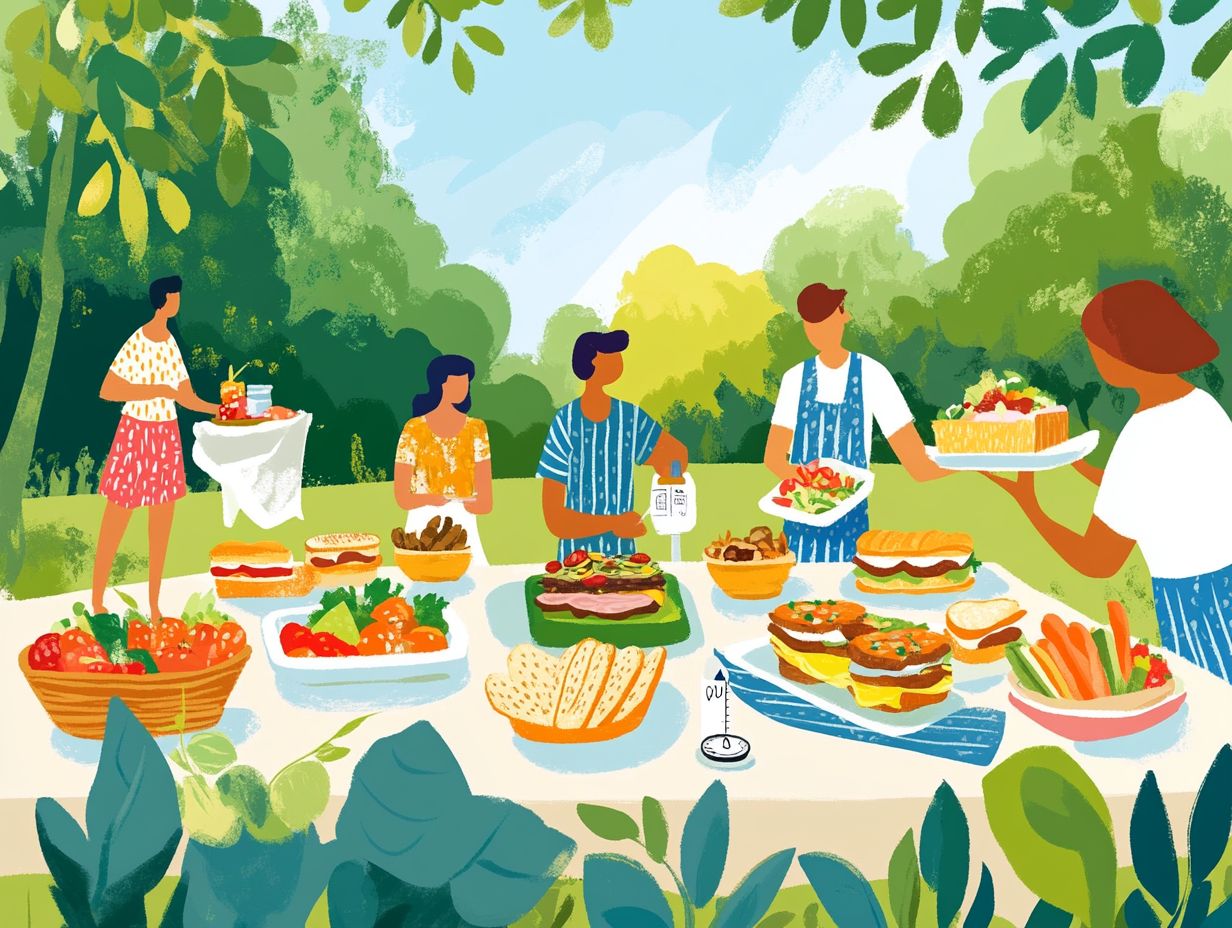
Using a thermometer to ensure your food reaches safe cooking temperatures is important in reducing the chance of food poisoning, especially during summer vacations, weddings, and events like the Super Bowl, where large groups gather to enjoy outdoor meals.
It’s important to know the USDA guidelines. For instance, ground meats should be cooked to an internal temperature of 160 F, while whole cuts of beef, pork, lamb, and veal must reach at least 145 F, followed by a three-minute rest period. Poultry should achieve a minimum safe temperature of 165 F.
Monitoring temperatures is not just about safety; it also preserves the quality, flavor, and texture of your dishes, enhancing everyone’s experience, especially during summer grilling events.
5. Store and Transport Food Safely
Proper storage and transportation of food are essential for food safety. This ensures that meals prepared for camping trips, back-to-school lunches, or potluck dinners remain safe to eat and free from contamination, particularly during Thanksgiving.
To uphold food safety, use insulated containers and coolers designed for keeping food cold during summer meals. These tools help regulate temperature and prevent bacterial growth during transport. Aim to keep perishable items below 40 F, and don’t forget those ice packs to keep your coolers chilled.
When it’s time to enjoy those meals, reheat with care make sure the food reaches at least 165 F to eliminate any potential pathogens, especially for food handlers.
Resources from organizations like the CDC and FDA offer invaluable guidelines on safe food practices, giving you the power to stay informed and compliant.
Why Is Food Safety Important for Outdoor Events?
Food safety is essential for your outdoor events. Improper food handling can lead to foodborne illnesses that not only ruin the joy of summer cookouts and holiday celebrations but also pose serious health risks to guests of all ages, especially during Thanksgiving and weddings.
Outdoor settings come with their own set of challenges, from fluctuating temperatures during summer grilling to a heightened risk of cross-contamination. This demands careful planning and strict adherence to safety guidelines. The U.S. Centers for Disease Control and Prevention (CDC) estimates that 48 million people fall ill from foodborne pathogens every year, underscoring the importance of vigilance when serving food outdoors.
By employing ways to keep food cold and maintaining hygiene, you can significantly reduce risks, allowing everyone to savor delicious meals without worry, ensuring they are healthy and full of delectable flavors.
Follow these tips to ensure safe and enjoyable meals for everyone!
What Are the Most Common Causes of Foodborne Illnesses?
The most common causes of foodborne illnesses, such as Salmonella and E. coli, often arise from improper cooking, handling, and storage of food. This is particularly true during outdoor events or summer vacations.
These pathogens, along with others like Listeria and Campylobacter, are often linked to undercooked meats, unpasteurized dairy products, and contaminated fruits and vegetables. Knowing how to keep food safe is very important. Engaging in safe food practices is essential to prevent these illnesses.
By washing your hands thoroughly before and after food preparation, keeping raw and cooked items separate, and ensuring all foods reach the recommended temperatures, you can make a real difference in keeping your loved ones safe especially during potluck dinners.
Proper refrigeration and timely consumption of leftovers are crucial for safeguarding your health, especially in communal dining settings or barbecues where cross-contamination is more likely during summer cookouts. Prioritizing these practices ensures a safe and enjoyable dining experience for everyone involved.
What Are the Best Ways to Keep Food Safe at Outdoor Events?
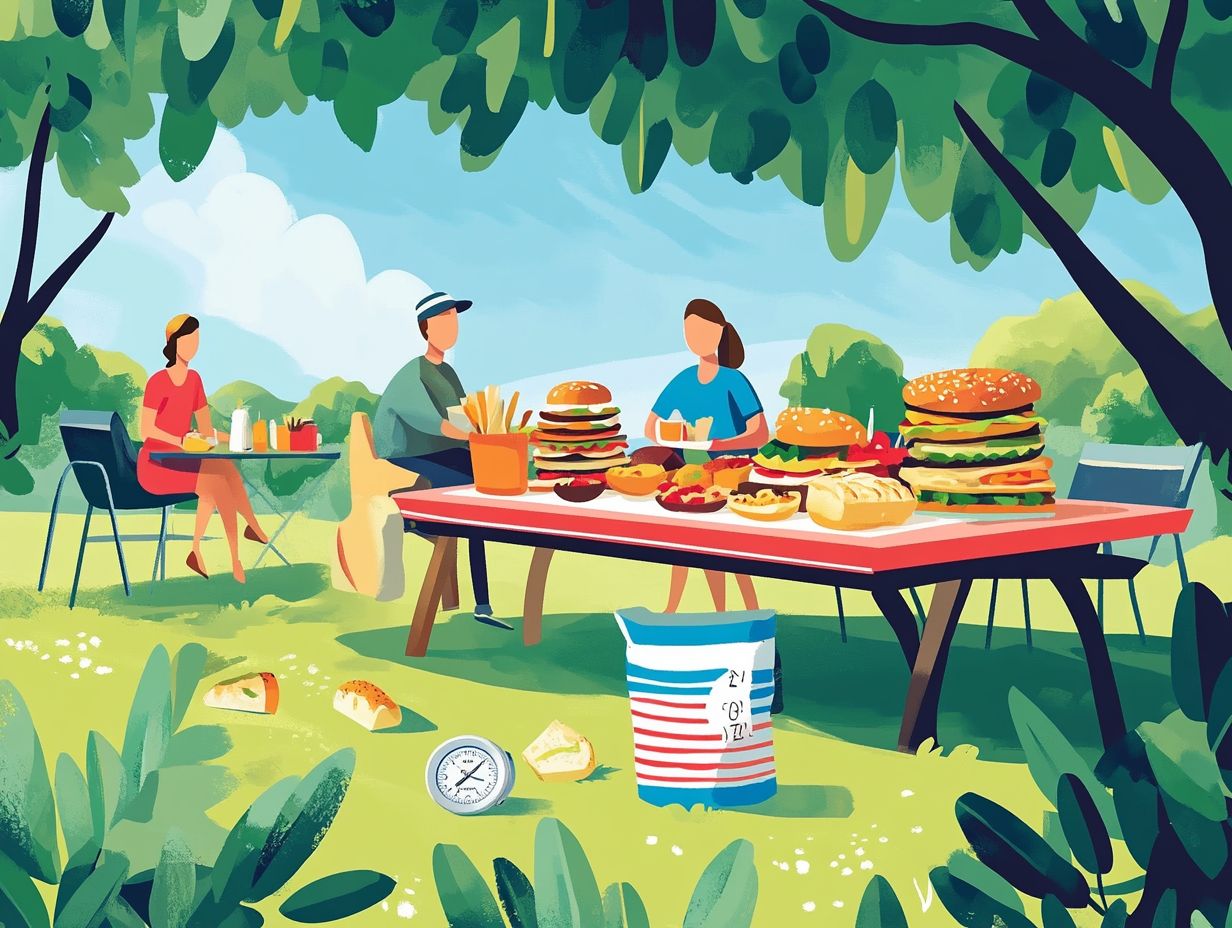
To ensure food safety at your outdoor events, it’s essential to implement food safety tips such as proper refrigeration, temperature monitoring, and safe handling techniques, especially for cooking outdoors. This approach effectively prevents foodborne illnesses.
For example, using a food thermometer a tool to check if food is cooked properly is crucial to guarantee that meats reach the appropriate internal temperature. This significantly reduces the risk of harmful bacteria, especially when cooking for groups.
Be mindful to avoid leaving perishable items exposed to temperatures between 40 F and 140 F for more than two hours; this range is known as the danger zone , particularly during summer meals.
During gatherings like barbecues or picnics, using coolers filled with ice for summer cookouts helps maintain a safe temperature for salads and desserts. Regularly checking the food’s temperature ensures everyone remains safe while enjoying their meal. By following these strategies, you enhance not just health but also the overall experience of dining outdoors during holiday celebrations.
What Are the Most Common Food Safety Mistakes Made at Outdoor Events?
Common food safety mistakes at outdoor events include neglecting personal hygiene, failing to monitor food temperatures, and improper food storage. These mistakes can cause foodborne illnesses during summer parties.
Such lapses endanger the safety of the dishes you serve and put the health of your friends and family at risk. Outdoor conditions can worsen these issues; for instance, increased heat can lead to faster spoilage of your favorite foods for outdoor meals.
Encouraging your guests to wash their hands before they dive into the food, using separate utensils for raw and cooked items, and placing coolers in shaded areas can significantly reduce these risks.
By educating attendees on the importance of maintaining appropriate food temperatures keeping cold foods below 40 F and hot foods above 140 F you’ll create a more enjoyable and safe dining experience for everyone involved.
Act now to ensure everyone’s safety at your events by implementing these essential food safety tips!
How Can You Educate Others about Food Safety at Outdoor Events?
Educating yourself and others about food safety at outdoor events is crucial. You can accomplish this effectively by using food safety resources from the CDC and FDA, volunteer guides, and hands-on demonstrations for food handlers during gatherings like potluck dinners.
To enhance your understanding, it s beneficial to create engaging resource materials outlining food safety tips for back-to-school holiday celebrations. These materials should outline best practices in food hygiene during Thanksgiving gatherings, such as proper temperature controls for safe temperatures, preventing the spread of bacteria from raw food to cooked food, and safe food storage techniques for summer grilling. Hosting interactive workshops allows you and other attendees to learn directly from experts, giving you the chance to practice methods firsthand, which significantly reinforces your knowledge.
Emphasizing food hygiene helps attendees understand their roles in preventing foodborne illnesses. For example, using visual aids for cooking and real-life scenarios of foodborne illness makes the concepts more relatable and memorable, ultimately fostering a safer gathering environment for weddings and celebrations for everyone involved.
What Are Some Tips for Safe Grilling at Outdoor Events?
To ensure safe grilling at your outdoor events, embrace food safety tips. This includes diligently monitoring temperatures, steering clear of cross-contamination, and cooking meats to the appropriate temperatures to prevent any risk of food poisoning.
Selecting the right tools is equally important. A reliable meat thermometer for monitoring during summer vacation can truly elevate your grilling game. Digital instant-read thermometers are fantastic for those quick checks, while probe thermometers will be your ally in monitoring the cooking process seamlessly.
In terms of determining doneness, the USDA (United States Department of Agriculture) provides specific temperature benchmarks to guide you:
- Chicken for Easter meals should reach a minimum of 165 F.
- Beef, pork, and lamb tips for Passover gatherings should be cooked to at least 145 F.
Maintaining hygiene practices is crucial as well. Always wash your hands before and after handling raw meats, and utilize separate utensils and serving dishes to prevent cross-contamination.
Avoid common pitfalls like neglecting to preheat the grill to avoid Salmonella or overcrowding to prevent E.coli contamination, as these can lead to uneven cooking. By following these guidelines, you ll pave the way for a safer and tastier outdoor grilling experience.
Frequently Asked Questions
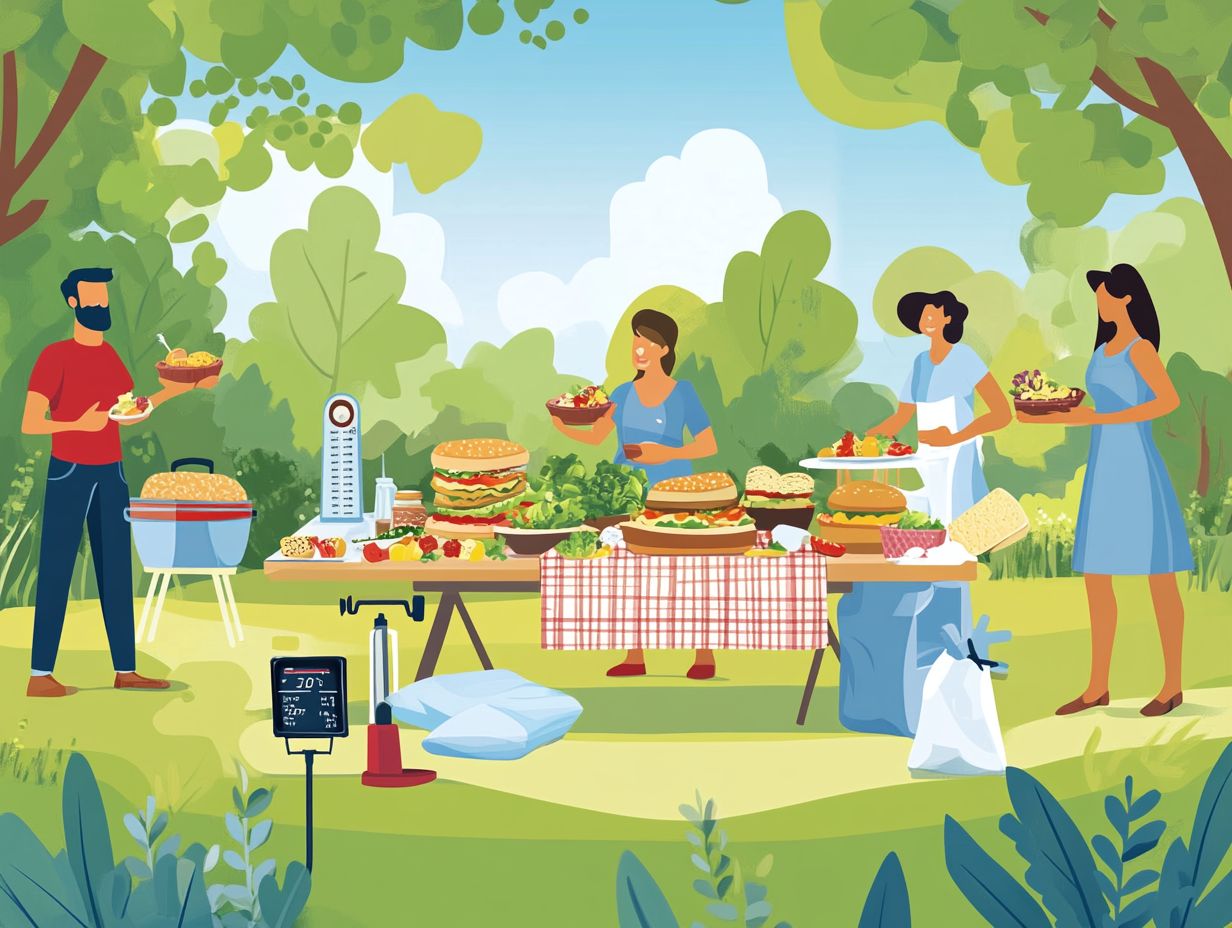
What are the top 5 food safety tips for outdoor events?
- Keep hot foods hot and cold foods cold: This means using proper storage methods and temperature controls to prevent foodborne illness.
- Wash your hands frequently: Make sure to wash your hands with soap and water before and after handling food to avoid cross-contamination.
- Use separate cutting boards for raw and cooked foods: This will prevent any potential bacteria from raw meat or seafood from spreading to other foods.
- Keep food covered and protected from insects and pests: Use food covers and keep all utensils and serving dishes covered when not in use to avoid contamination.
- Pack and store food properly: Use insulated coolers and ice packs to keep cold foods below 40 F and hot foods above 140 F during transportation to the event.
Why is it important to keep hot and cold foods at the right temperatures?
Improper temperature control can lead to the growth of harmful bacteria that can cause foodborne illness. Hot foods should be kept above 140 F to prevent bacterial growth, while cold foods should be kept below 40 F to slow down bacterial growth.
How often should I wash my hands when handling food at an outdoor event?
You should wash your hands before and after handling food, especially if you are touching raw meat or utensils that have come into contact with raw food. It is also a good idea to wash your hands after using the restroom or touching any other potentially contaminated surfaces.
Why is it important to use separate cutting boards for raw and cooked foods?
Raw meats and seafood can harbor harmful bacteria. These bacteria can easily spread to other foods if they share the same cutting board.
Using separate cutting boards helps prevent cross-contamination. This keeps your food safe to eat.
How can I protect my food from insects and pests at an outdoor event?
Cover your food with food covers to keep insects away. Also, keep utensils and serving dishes covered when not in use.
Set up food in a shaded area. Avoid leaving food out for too long to reduce the risk of contamination.
What are some ways to properly pack and store food for an outdoor event?
Use insulated coolers and ice packs to keep cold foods below 40 F. Hot foods should stay above 140 F during transportation.
Consider using separate coolers for drinks and food. This prevents frequent opening and closing of the cooler.
Keep raw meats and seafood separate from other foods in the cooler. This ensures food safety throughout your event.

